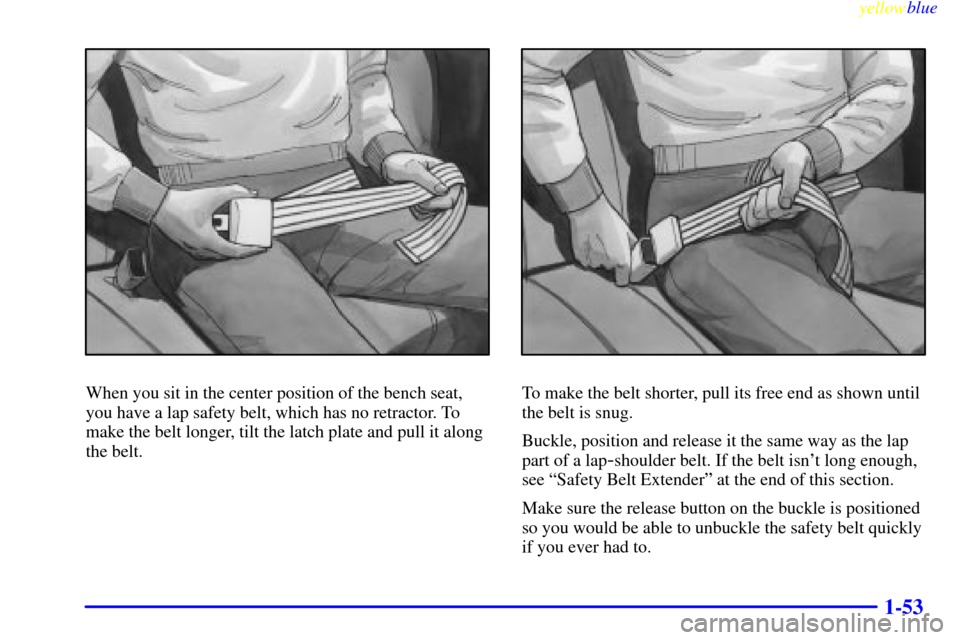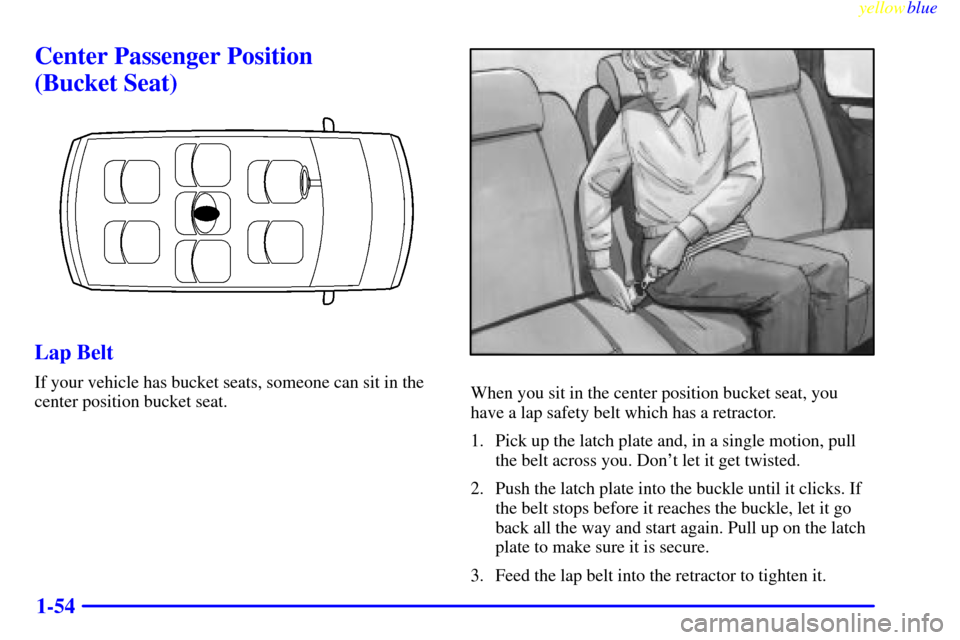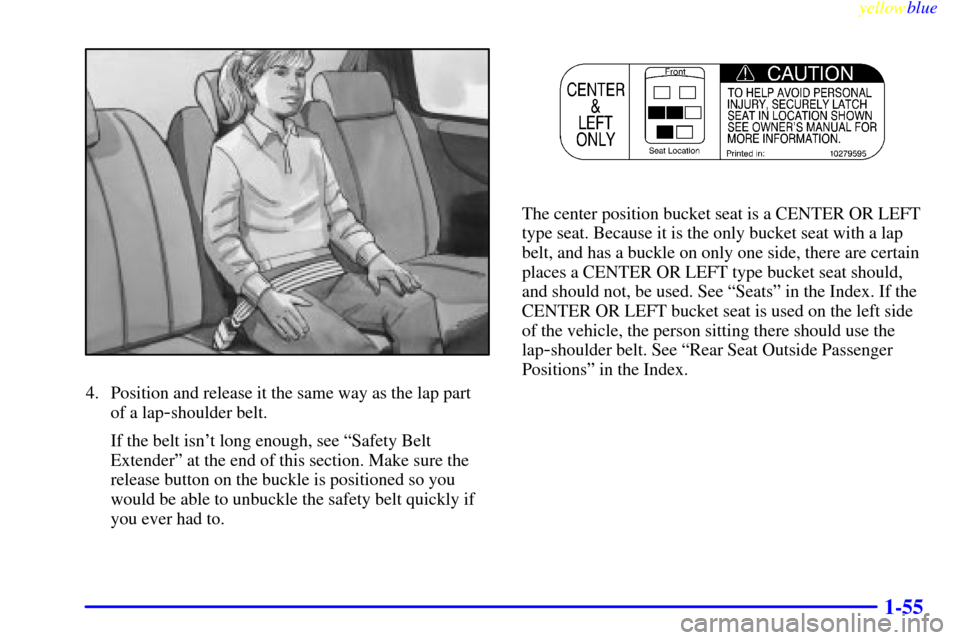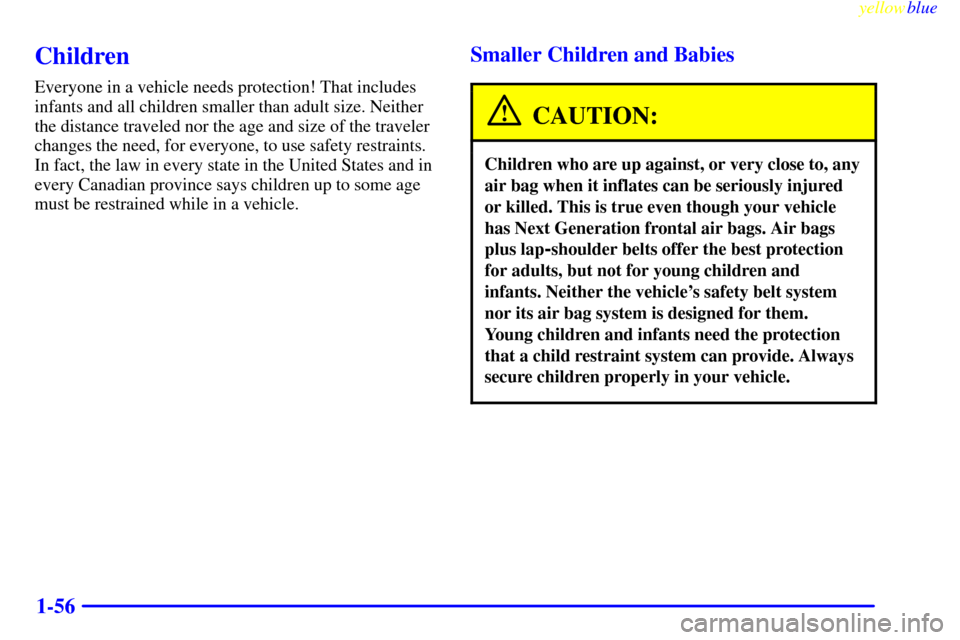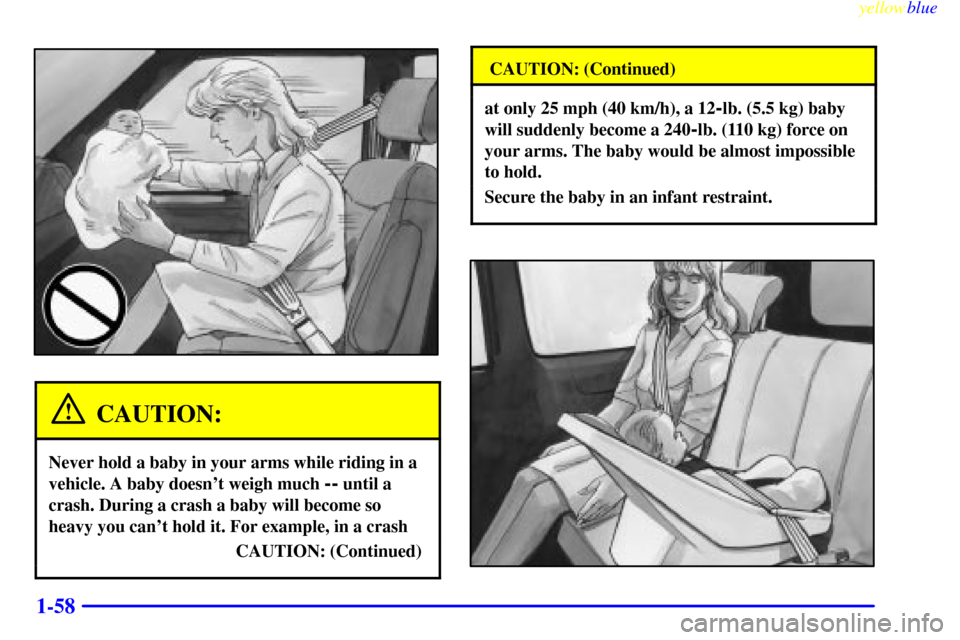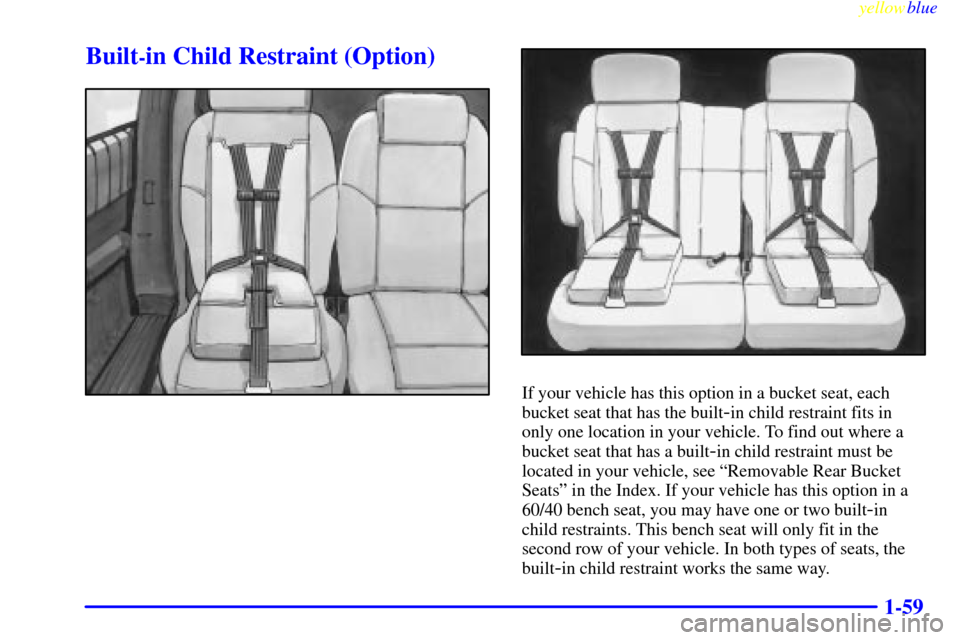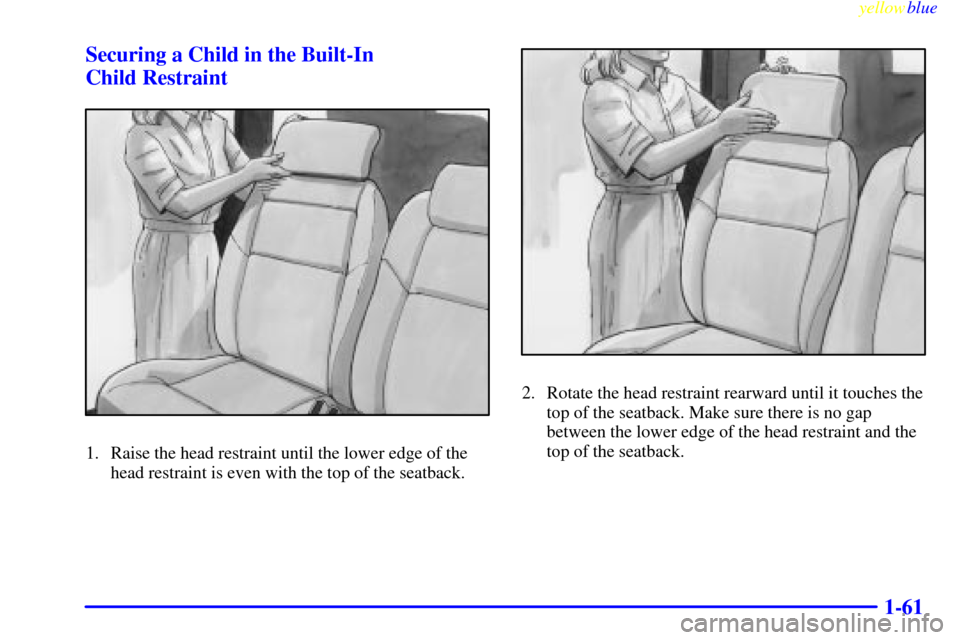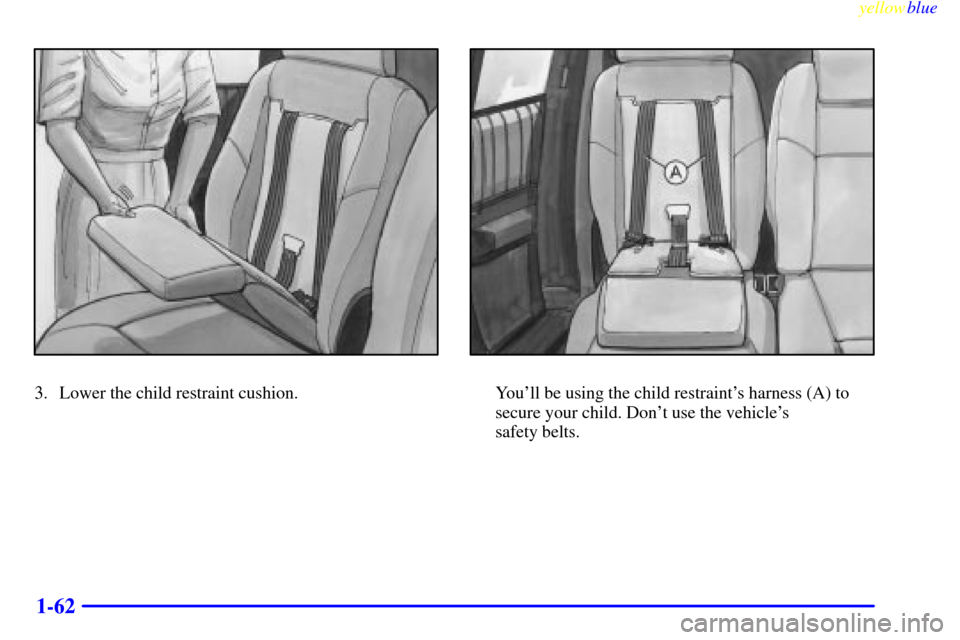CHEVROLET VENTURE 1999 1.G Repair Manual
VENTURE 1999 1.G
CHEVROLET
CHEVROLET
https://www.carmanualsonline.info/img/24/8383/w960_8383-0.png
CHEVROLET VENTURE 1999 1.G Repair Manual
Trending: oil pressure, instrument cluster, oil capacity, traction control, audio, turn signal bulb, windshield wipers
Page 61 of 440
yellowblue
1-53
When you sit in the center position of the bench seat,
you have a lap safety belt, which has no retractor. To
make the belt longer, tilt the latch plate and pull it along
the belt.To make the belt shorter, pull its free end as shown until
the belt is snug.
Buckle, position and release it the same way as the lap
part of a lap
-shoulder belt. If the belt isn't long enough,
see ªSafety Belt Extenderº at the end of this section.
Make sure the release button on the buckle is positioned
so you would be able to unbuckle the safety belt quickly
if you ever had to.
Page 62 of 440
yellowblue
1-54
Center Passenger Position
(Bucket Seat)
Lap Belt
If your vehicle has bucket seats, someone can sit in the
center position bucket seat.When you sit in the center position bucket seat, you
have a lap safety belt which has a retractor.
1. Pick up the latch plate and, in a single motion, pull
the belt across you. Don't let it get twisted.
2. Push the latch plate into the buckle until it clicks. If
the belt stops before it reaches the buckle, let it go
back all the way and start again. Pull up on the latch
plate to make sure it is secure.
3. Feed the lap belt into the retractor to tighten it.
Page 63 of 440
yellowblue
1-55
4. Position and release it the same way as the lap part
of a lap
-shoulder belt.
If the belt isn't long enough, see ªSafety Belt
Extenderº at the end of this section. Make sure the
release button on the buckle is positioned so you
would be able to unbuckle the safety belt quickly if
you ever had to.
The center position bucket seat is a CENTER OR LEFT
type seat. Because it is the only bucket seat with a lap
belt, and has a buckle on only one side, there are certain
places a CENTER OR LEFT type bucket seat should,
and should not, be used. See ªSeatsº in the Index. If the
CENTER OR LEFT bucket seat is used on the left side
of the vehicle, the person sitting there should use the
lap
-shoulder belt. See ªRear Seat Outside Passenger
Positionsº in the Index.
Page 64 of 440
yellowblue
1-56
Children
Everyone in a vehicle needs protection! That includes
infants and all children smaller than adult size. Neither
the distance traveled nor the age and size of the traveler
changes the need, for everyone, to use safety restraints.
In fact, the law in every state in the United States and in
every Canadian province says children up to some age
must be restrained while in a vehicle.
Smaller Children and Babies
CAUTION:
Children who are up against, or very close to, any
air bag when it inflates can be seriously injured
or killed. This is true even though your vehicle
has Next Generation frontal air bags. Air bags
plus lap
-shoulder belts offer the best protection
for adults, but not for young children and
infants. Neither the vehicle's safety belt system
nor its air bag system is designed for them.
Young children and infants need the protection
that a child restraint system can provide. Always
secure children properly in your vehicle.
Page 65 of 440
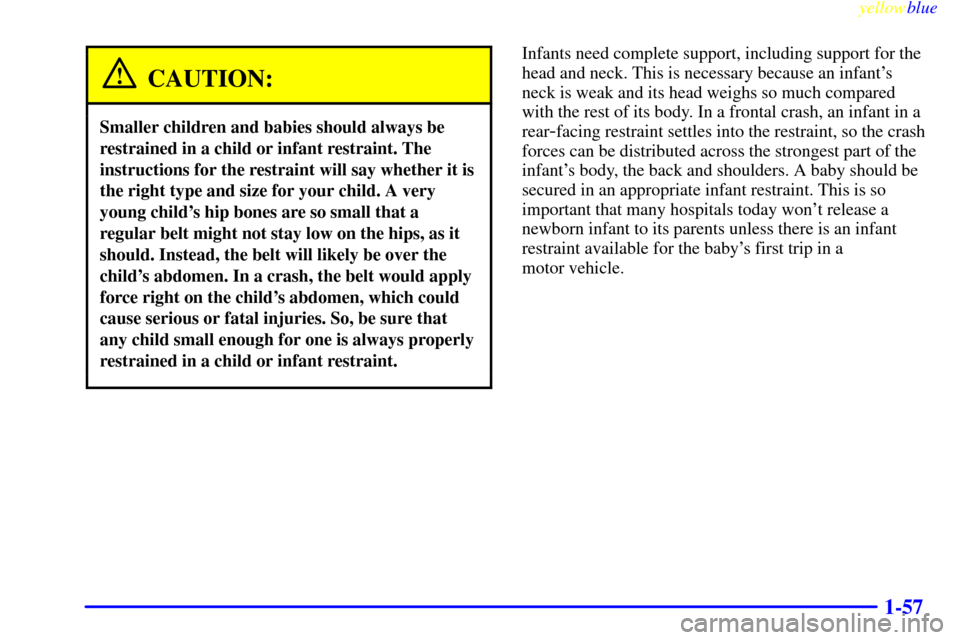
yellowblue
1-57
CAUTION:
Smaller children and babies should always be
restrained in a child or infant restraint. The
instructions for the restraint will say whether it is
the right type and size for your child. A very
young child's hip bones are so small that a
regular belt might not stay low on the hips, as it
should. Instead, the belt will likely be over the
child's abdomen. In a crash, the belt would apply
force right on the child's abdomen, which could
cause serious or fatal injuries. So, be sure that
any child small enough for one is always properly
restrained in a child or infant restraint.
Infants need complete support, including support for the
head and neck. This is necessary because an infant's
neck is weak and its head weighs so much compared
with the rest of its body. In a frontal crash, an infant in a
rear
-facing restraint settles into the restraint, so the crash
forces can be distributed across the strongest part of the
infant's body, the back and shoulders. A baby should be
secured in an appropriate infant restraint. This is so
important that many hospitals today won't release a
newborn infant to its parents unless there is an infant
restraint available for the baby's first trip in a
motor vehicle.
Page 66 of 440
yellowblue
1-58
CAUTION:
Never hold a baby in your arms while riding in a
vehicle. A baby doesn't weigh much
-- until a
crash. During a crash a baby will become so
heavy you can't hold it. For example, in a crash
CAUTION: (Continued)
CAUTION: (Continued)
at only 25 mph (40 km/h), a 12-lb. (5.5 kg) baby
will suddenly become a 240
-lb. (110 kg) force on
your arms. The baby would be almost impossible
to hold.
Secure the baby in an infant restraint.
Page 67 of 440
yellowblue
1-59
Built-in Child Restraint (Option)
If your vehicle has this option in a bucket seat, each
bucket seat that has the built
-in child restraint fits in
only one location in your vehicle. To find out where a
bucket seat that has a built
-in child restraint must be
located in your vehicle, see ªRemovable Rear Bucket
Seatsº in the Index. If your vehicle has this option in a
60/40 bench seat, you may have one or two built
-in
child restraints. This bench seat will only fit in the
second row of your vehicle. In both types of seats, the
built
-in child restraint works the same way.
Page 68 of 440
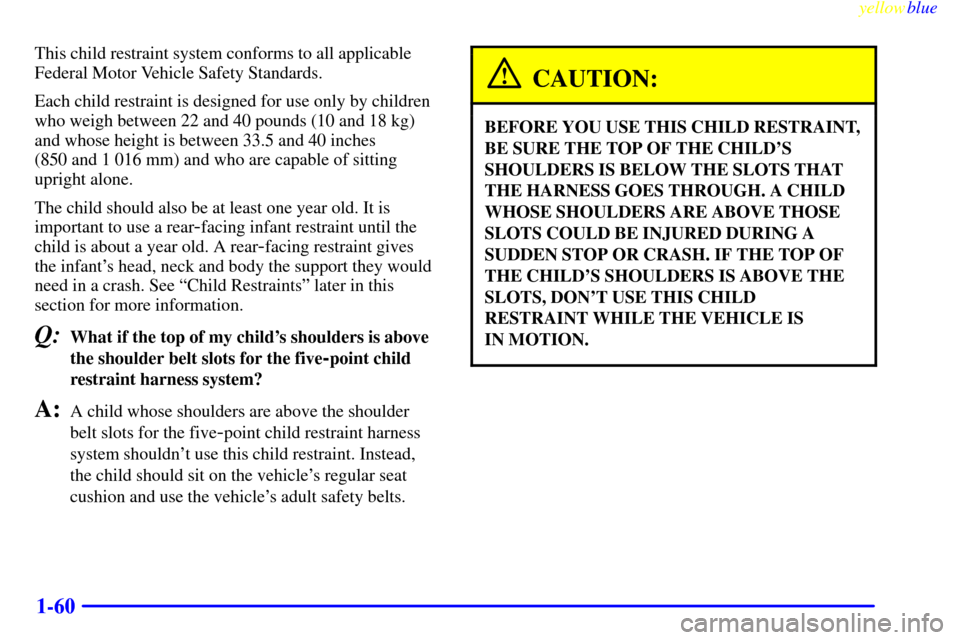
yellowblue
1-60
This child restraint system conforms to all applicable
Federal Motor Vehicle Safety Standards.
Each child restraint is designed for use only by children
who weigh between 22 and 40 pounds (10 and 18 kg)
and whose height is between 33.5 and 40 inches
(850 and 1 016 mm) and who are capable of sitting
upright alone.
The child should also be at least one year old. It is
important to use a rear
-facing infant restraint until the
child is about a year old. A rear
-facing restraint gives
the infant's head, neck and body the support they would
need in a crash. See ªChild Restraintsº later in this
section for more information.
Q:What if the top of my child's shoulders is above
the shoulder belt slots for the five
-point child
restraint harness system?
A:A child whose shoulders are above the shoulder
belt slots for the five
-point child restraint harness
system shouldn't use this child restraint. Instead,
the child should sit on the vehicle's regular seat
cushion and use the vehicle's adult safety belts.
CAUTION:
BEFORE YOU USE THIS CHILD RESTRAINT,
BE SURE THE TOP OF THE CHILD'S
SHOULDERS IS BELOW THE SLOTS THAT
THE HARNESS GOES THROUGH. A CHILD
WHOSE SHOULDERS ARE ABOVE THOSE
SLOTS COULD BE INJURED DURING A
SUDDEN STOP OR CRASH. IF THE TOP OF
THE CHILD'S SHOULDERS IS ABOVE THE
SLOTS, DON'T USE THIS CHILD
RESTRAINT WHILE THE VEHICLE IS
IN MOTION.
Page 69 of 440
yellowblue
1-61 Securing a Child in the Built-In
Child Restraint
1. Raise the head restraint until the lower edge of the
head restraint is even with the top of the seatback.
2. Rotate the head restraint rearward until it touches the
top of the seatback. Make sure there is no gap
between the lower edge of the head restraint and the
top of the seatback.
Page 70 of 440
yellowblue
1-62
3. Lower the child restraint cushion.You'll be using the child restraint's harness (A) to
secure your child. Don't use the vehicle's
safety belts.
Trending: display, interior lights, width, low oil pressure, remote control, keyless, fuel cap release
